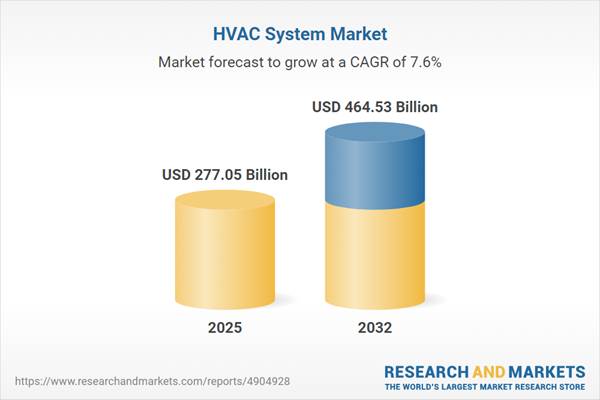Speak directly to the analyst to clarify any post sales queries you may have.
The HVAC system market is evolving rapidly as shifting regulations and emerging technologies require senior decision-makers to reassess procurement, investment, and compliance strategies. Leaders must demonstrate market adaptability to sustain operational continuity and create new growth potential in a changing environment.
Market Snapshot: HVAC System Market Demand and Growth
In 2024, the global HVAC system market was valued at USD 258.15 billion and is projected to grow to USD 277.05 billion by 2025. The sector is expected to achieve a CAGR of 7.61% through 2032, with an anticipated market value of USD 464.53 billion. Growth is shaped by rising requirements for energy efficiency, adherence to environmental regulations, and modernization trends across varied facility types. Organizations are investing in updated controls, system enhancements, and adaptable designs to fulfill tightening compliance and sustainability mandates. Executive leaders play a pivotal role in identifying risks, realizing long-term value, and embracing sector changes that drive future momentum.
Scope & Segmentation: Comprehensive Market Coverage
- Equipment Types: Air conditioners, chillers, furnaces, heat pumps, and variable refrigerant flow systems diversify offerings for climate management, operational flexibility, and building-owner needs.
- System Types: Central, ductless, packaged, and split system options enable customized temperature control and scalable deployment across varying facility sizes.
- Installation Types: Retrofit and initial installation services support both upgrades and new system integrations, minimizing workflow disruption and boosting operational efficiency.
- Applications: Solutions span heating, cooling, ventilation, and hybrid systems, emphasizing regulatory compliance, indoor air quality, and peak building performance.
- End-Use Sectors: Deployments serve commercial, industrial, and residential facilities as well as specialized domains such as healthcare, retail, and hospitality, each with tailored compliance priorities.
- Distribution Channels: Inclusion of retail and digital procurement channels ensures responsive supply, supporting timely maintenance and replacement needs in dynamic markets.
- Regions: Diverse regulatory requirements and economic conditions in the Americas, Europe, Middle East, Africa, and Asia-Pacific influence localization and market-entry approaches.
- Technologies and Solutions: The adoption of smart controls, IoT integration, sustainable refrigerants, and hybrid innovations bolsters predictive maintenance, analytics-driven monitoring, and sustainability compliance.
Key Takeaways for Executive Leadership
- Digital HVAC platforms and modular system design enable organizations to respond swiftly to changing technology standards and evolving policies.
- Pursuing hybrid and responsible HVAC solutions aligns with environmental goals while supporting asset value in the face of regulatory change.
- Diversifying procurement with multiple sourcing options reduces exposure to supply chain and compliance disruptions, strengthening operational continuity.
- Utilizing advanced analytics for vendor and supplier evaluation increases procurement transparency and builds sustainable long-term supplier relationships.
- Early collaboration with technology providers allows executive teams to anticipate sector shifts, refine strategies, and remain agile.
Tariff Impact: Navigating Regulatory Changes in 2025
Forthcoming U.S. tariff adjustments in 2025 are poised to impact HVAC component costs. Senior procurement leaders should consider strengthening domestic sourcing options and creating flexible supplier networks. Evaluating refurbished components and adaptable procurement processes can enhance supply chain resilience and ensure operational continuity as policy frameworks evolve.
Methodology & Data Sources
This analysis integrates direct feedback from industry executives, structured regulatory reviews, and triangulated data from several leading HVAC market studies. Validation by an expert panel ensures findings are actionable and highly relevant for senior leadership navigating current market complexities.
Why This Report Matters
- Connects ongoing regulatory, technology, and sustainability priorities to executive-level planning and strategic response across global HVAC markets.
- Provides actionable segmentation insights to support robust procurement and operational decisions for diverse end-use sectors.
- Presents recommendations that aid in resource allocation, risk management, and investment planning amid ongoing sector evolution.
Conclusion
Informed HVAC system market intelligence enables executive teams to anticipate industry shifts, optimize compliance efforts, and create strategies that strengthen organizational performance and resilience.
Additional Product Information:
- Purchase of this report includes 1 year online access with quarterly updates.
- This report can be updated on request. Please contact our Customer Experience team using the Ask a Question widget on our website.
Table of Contents
3. Executive Summary
4. Market Overview
7. Cumulative Impact of Artificial Intelligence 2025
Companies Mentioned
The companies profiled in this HVAC System market report include:- Carrier Global Corporation
- LG Electronics Inc.
- Daikin Industries, Ltd.
- Trane Technologies PLC
- Johnson Controls International PLC
- Lennox International Inc.
- Mitsubishi Electric Corporation
- Robert Bosch GmbH
- Hitachi, Ltd.
- Fujitsu General Limited
- ABB Ltd.
- AF Gruppen ASA
- Trane Technologies PLC
- Danfoss A/S
- Electrolux AB
- Emerson Electric Co.
- Ferroli S.p.A.
- Haier Group
- Heinen & Hopman Engineering BV
- Honeywell International Inc.
- Ingersoll Rand Inc.
- Menerga GmbH
- Midea Group Co. Ltd.
- Nortek Air Solutions, LLC
- Panasonic Corporation
- Qingdao Hisense HVAC equipment Co., Ltd.
- Rheem Manufacturing Company
- Samsung Electronics Co., Ltd.
- Schneider Electric SE
- Sharp Corporation
- Siemens AG
- Toshiba Corporation
- Voltas Limited
- Whirlpool Corporation
Table Information
| Report Attribute | Details |
|---|---|
| No. of Pages | 185 |
| Published | November 2025 |
| Forecast Period | 2025 - 2032 |
| Estimated Market Value ( USD | $ 277.05 Billion |
| Forecasted Market Value ( USD | $ 464.53 Billion |
| Compound Annual Growth Rate | 7.6% |
| Regions Covered | Global |
| No. of Companies Mentioned | 35 |









